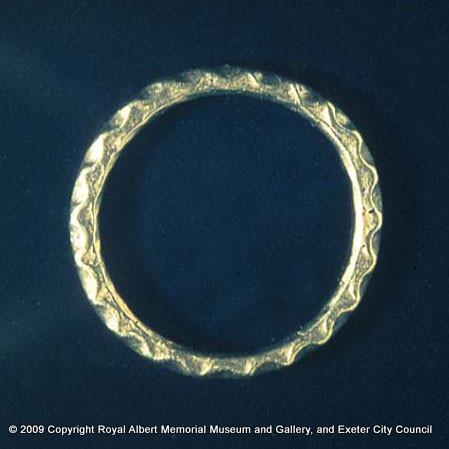A Middle Saxon gold finger–ring
Back to Time Period
In his publication of the ring, Dr J. Graham-Campbell described the find as follows: 'During the excavations of 1971 outside the west front of Exeter Cathedral, a gold finger-ring was found in a grave in the Middle Saxon cemetery. The grave was an ordinary inhumation with no signs of a coffin, cut into the surface of a Roman road. The ring lay close by the upper right arm of the body and so it appears to have been deliberately placed in the grave alongside the dead person.
The ring consists of a circular closed band of gold, with an external diameter of 2.7cm. Its large size is in accord with that of several ninth-century Anglo-Saxon rings. The simple ornament consists of a continuous row of small lozenge-shaped fields around the outside of the hoop, created by hammering facets along its outer edges. There exist several 9th-century Anglo-Saxon gold finger-rings consisting of bands of constant width with continuous ornament or inscriptions running around them, but the Exeter ring is without exact parallel.The closest parallel is provided by one of the lost silver finger-rings from the Trewhiddle, Cornwall hoard, deposited c. 872-5
The Middle Saxon date suggested for the Exeter ring by virtue of its archaeological context is consistent with the evidence of its form, size and decoration, in that these features are closer to those of 9th-century Anglo-Saxon rings than they are to those of finger-rings of Roman or early Anglo-Saxon date.'
Publication: Graham-Campbell, J. 1982: 'Antiquaries Journal', Vol. 62.
Acknowledgments: © 2015 Royal Albert Memorial Museum & Art Gallery, Exeter City Council



















